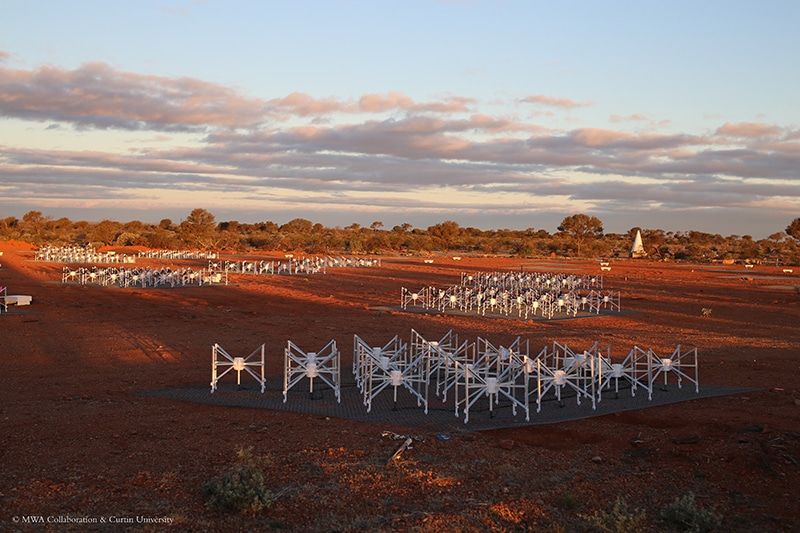Nov 27 2019
Nearly 12 billion years ago, the universe evolved from a great cosmic dark age, with the lighting up of the first stars and galaxies.
 The Murchison Widefield Array radio telescope, a portion of which is pictured here, is searching for a signal emitted during the formation of the first stars in the universe. Image Credit: Goldsmith/MWA Collaboration/Curtin University.
The Murchison Widefield Array radio telescope, a portion of which is pictured here, is searching for a signal emitted during the formation of the first stars in the universe. Image Credit: Goldsmith/MWA Collaboration/Curtin University.
Now, researchers have made a fresh analysis of data gathered by the Murchison Widefield Array (MWA) radio telescope to get closer than ever to finding the ultra-faint signature of this turning point in cosmic history.
In a paper currently available on the preprint site ArXiv and to be published soon in The Astrophysical Journal, the researchers describe the first analysis of data from a new configuration of the MWA exclusively developed to search for the signal of neutral hydrogen, the dominant gas in the universe during the cosmic dark age. The analysis sets a new limit—the lowest limit to date—for the neutral hydrogen signal strength.
We can say with confidence that if the neutral hydrogen signal was any stronger than the limit we set in the paper, then the telescope would have detected it. These findings can help us to further constrain the timing of when the cosmic dark ages ended and the first stars emerged.
Jonathan Pober, Assistant Professor of Physics, Brown University
Pober is also the corresponding author of the new paper. The study was headed by Wenyang Li, who carried out the research as a PhD student at Brown. Li and Pober joined hands with an international team of researchers working with the MWA.
In spite of its significance in cosmic history, the knowledge about the period when the first stars formed, called the Epoch of Reionization (EoR), is very little. Positively charged hydrogen ions are the first atoms to form after the Big Bang. The electrons of these atoms were stripped away by the energy of the young universe.
With cooling and expansion of the universe, hydrogen atoms recombined with their electrons to form neutral hydrogen. Only these were present in the universe until nearly 12 billion years ago, when atoms began clustering together to form stars and galaxies. Light emitted from those objects re-ionized the neutral hydrogen, making it vanish mostly from interstellar space.
The aim of the studies such as the one underway at MWA is to detect and find the signal of neutral hydrogen from the dark ages and quantify how it changed with the unfolding of the EoR. In so doing, new and vital information about the first stars—the building blocks of the universe we see today—could be unraveled. However, it is challenging to have a glimpse of that 12-billion-year-old signal, and necessitates instruments with excellent sensitivity.
The MWA started its operations in 2013, and at that time, it was an array of 2,048 radio antennas positioned across the remote countryside of Western Australia. The antennas are clustered together into 128 “tiles,” signals from which are combined by a supercomputer known as the Correlator.
The number of tiles was doubled to 256 in 2016, and their configuration over the landscape was modified to optimize their sensitivity to the neutral hydrogen signal. This new study is the first-ever analysis of data obtained from the expanded array.
The wavelength of the radiation emitted by neutral hydrogen is 21 cm. With the expansion of the universe over the past 12 billion years, currently, the signal from the EoR is stretched to about 2 m. This is exactly what MWA astronomers are looking for.
The challenge is that there are several other sources emitting at the same wavelength—human-made sources such as digital television, and natural sources from within the Milky Way, as well as from millions of other galaxies.
All of these other sources are many orders of magnitude stronger than the signal we’re trying to detect. Even an FM radio signal that’s reflected off an airplane that happens to be passing above the telescope is enough to contaminate the data.
Jonathan Pober, Assistant Professor of Physics, Brown University
The researchers tried to home in on the signal by using a range of processing methods to eliminate those contaminants. They also accounted for the distinct frequency responses of the telescope itself.
“If we look at different radio frequencies or wavelengths, the telescope behaves a little differently,” stated Pober. “Correcting for the telescope response is absolutely critical for then doing the separation of astrophysical contaminants and the signal of interest.”
Those data analysis methods together with the augmented capacity of the telescope itself led to a new upper limit of the EoR signal strength. It is the second consecutive best-limit-to-date analysis to be launched by MWA and increases the hope that someday, the experiment will detect the elusive EoR signal.
This analysis demonstrates that the phase two upgrade had a lot of its desired effects and that the new analysis techniques will improve future analyses. The fact that MWA has now published back-to-back the two best limits on the signal gives momentum to the idea that this experiment and its approach has a lot of promise.
Jonathan Pober, Assistant Professor of Physics, Brown University
The study was partially supported by the U.S. National Science Foundation (grant #1613040). The MWA is supported by the Australian government and acknowledges Wajarri Yamatji people as the traditional owners of the observatory site.